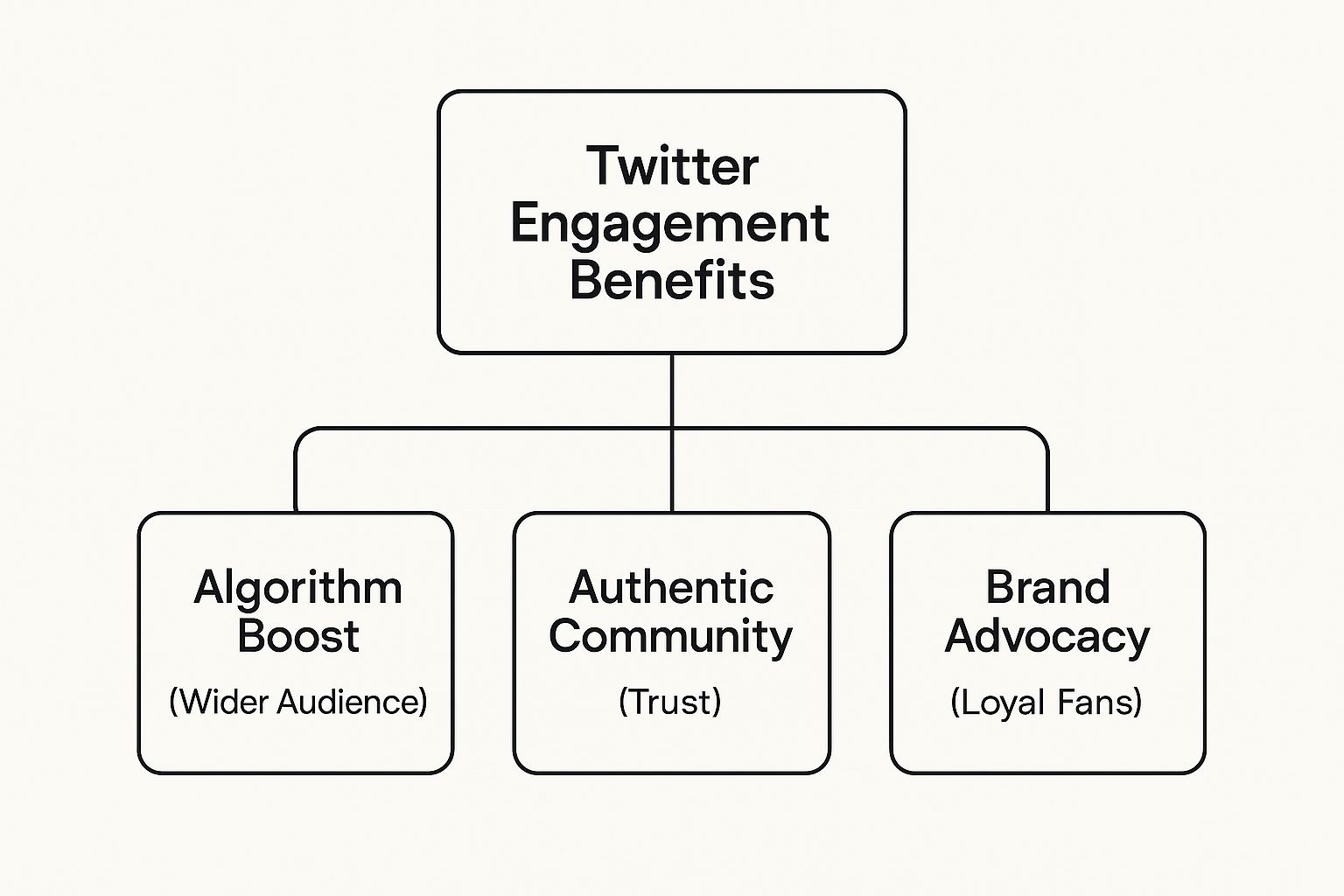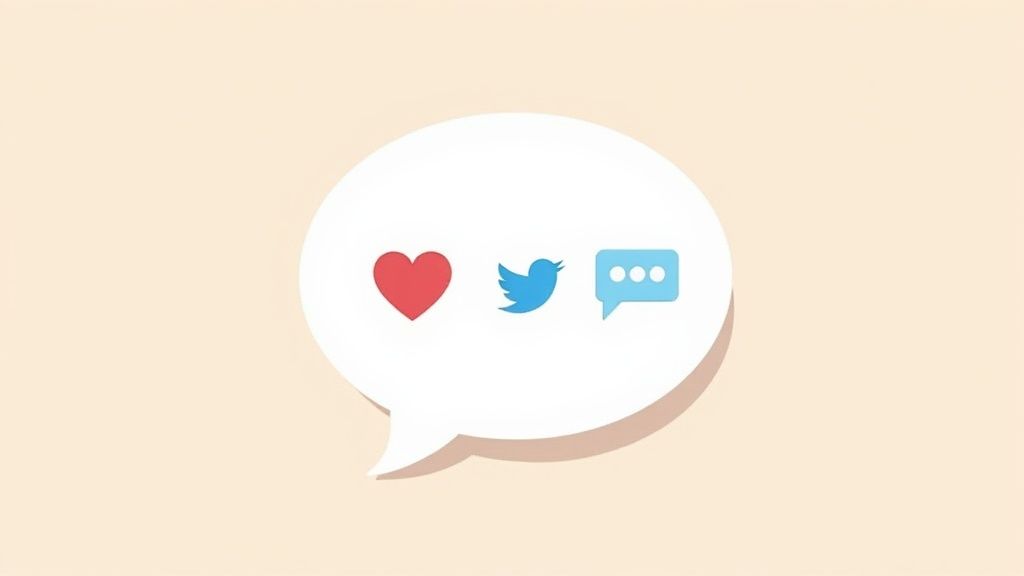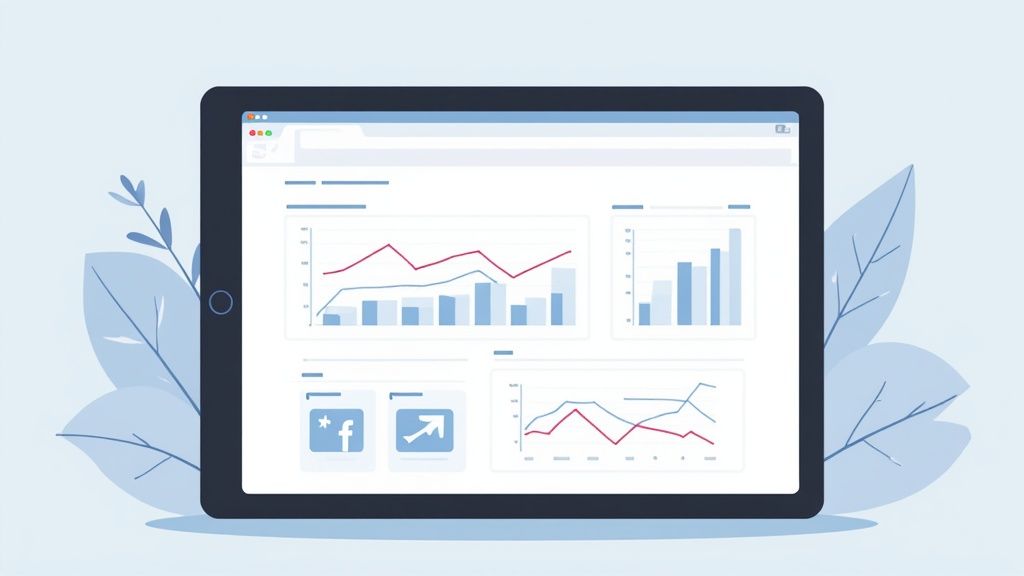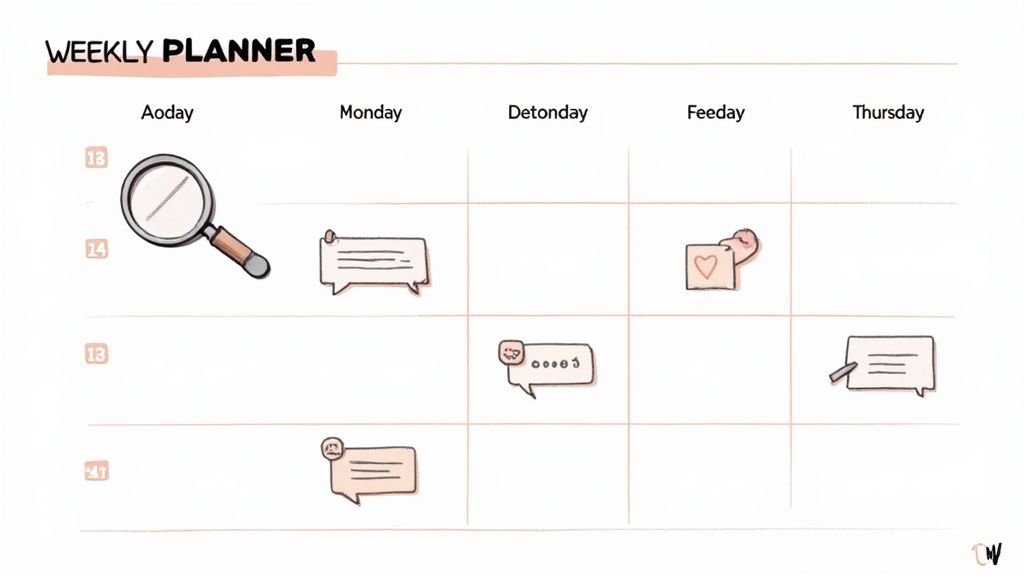Let’s get one thing straight: true Twitter engagement isn’t about vanity metrics like how many followers you have. It’s about real, human interactions—the likes, replies, and retweets that show people are actually listening and care about what you’re saying. This is the real currency on Twitter, the stuff that builds influence and gets you noticed.
Why Twitter Engagement Actually Matters
Think of Twitter as a busy coffee shop. You can scream to the masses and be heard nothing, or engage in a real conversation that gets people leaning in.
Having a lot of followers is wonderful, but engagement is when people are hearing you, responding to you, and sharing your message with others.
This kind of interaction pleases the Twitter algorithm, and it will give you promoted tweets to more individuals and give you organic reach that cannot be purchased.
From Followers to Brand Advocates
Good engagement does more than just feed the algorithm; it builds a real community around your brand. Every reply is an opportunity to build trust. Every retweet is a public endorsement.
Slowly but surely, this process turns passive followers into loyal advocates who will support your brand, share your message, and even stand up for you. At the end of the day, strong engagement leads to a stronger brand and a healthier bottom line. Understanding your social media ROI starts right here, with the value of these simple interactions.
The infographic below breaks down how these benefits build on each other.

As you can see, it’s a clear progression. Engagement drives visibility, which builds community trust, which in turn creates powerful brand advocacy.
Analyzing Engagement Patterns
So what drives these interactions? Twitter activity isn’t random — it’s dependent on what you’re tweeting, when you’re tweeting, and who you’re tweeting.
Going over your previous performance allows you to observe trends, such as what topics or times of day elicit the most responses. These insights allow you to tweet deliberately and interact with your followers when they’re most active.
Learning the Language of Twitter Metrics

To really get a handle on Twitter tweet engagement, you have to learn what your analytics are trying to tell you.
Each measurement is more than a number—it’s a chunk of raw feedback from your users. It tells you what they think, what they care about, and what gets them going. Imagine it as learning a new language where each click and each scroll equates to a particular human response.
Once you start interpreting these signals, you are no longer just throwing things out into the wind and instead are having a real, strategic conversation. You don’t have to guess anymore and can start making smart, data-driven decisions that build an actually engaged community around your brand.
The Core Engagement Metrics
At the heart of Twitter are a few key interactions that reveal how people respond to your content. Each represents a different level of interest, from a quick glance to active participation. Understanding this hierarchy is essential to measure real performance.
Let’s break down the core metrics:
-
Impressions: How many times your tweet appeared on someone’s screen — a measure of visibility, not engagement.
-
Likes: A simple sign of approval that shows your content resonated on a basic level.
-
Retweets: Public endorsements that extend your reach to new audiences.
-
Replies: Direct conversations showing genuine interest and connection.
These four metrics provide a clear snapshot of how your content performs — the foundation for deeper engagement analysis.
Digging Deeper Into What People Do Next
Beyond the big four, other metrics show what your audience does after they see your tweet. These actions signal a much deeper level of interest and are absolutely vital for understanding the true impact of your content.
Your goal isn’t just to make people stop scrolling; it’s to inspire them to take an action. Whether it’s a click, a profile visit, or a follow, these secondary metrics are often where the real business value lies.
These next-level metrics reveal what your audience truly values:
-
Link Clicks: Show how often people click links in your tweets — a key indicator of how effectively your content drives traffic to your site or landing pages.
-
Profile Visits: Indicate curiosity and interest. When people visit your profile, it’s often the first step toward turning casual viewers into followers.
-
Hashtag Clicks: Measure how well your hashtags connect your tweets to wider, trending conversations.
Looking at both primary and secondary metrics together gives you the full picture. For example, high impressions but few link clicks may mean your hook needs improvement, while many profile visits suggest your content is sparking genuine curiosity. This holistic view helps you refine your strategy and create content that inspires action, not just attention.
What the Industry Says , Engagement Benchmarks for X
Before you dive too deep into analytics, it helps to know what “good” looks like across the platform.
-
The median engagement rate on X (formerly Twitter) across industries in 2024 was 0.029%, according to Rival IQ.
-
Top-performing brands reach around 0.08%, while smaller, niche accounts can often exceed 0.5–1%, which is considered strong for organic engagement.
Knowing these benchmarks helps you evaluate whether your performance is above or below industry standards — and gives you a baseline for realistic growth goals.
5 Proven Strategies to Boost Your Tweet Engagement
Alright, you’ve got the metrics. Now the fun stuff: using that information. Growing your Twitter engagement isn’t about finding some silver bullet. It’s about executing a couple of good strategies on a consistent basis that get people to set down the scroll and grab hold of the engage.
Think of your Twitter feed like it was a theater. Your job is to make an experience so compelling that the audience can’t help but cheer, comment, and re-tweet. Each of the following will do this, turning passive spectators into active participants.
1. Ask Questions That Invite Participation
The easiest way to start a conversation is by asking a question — but it needs to invite real participation, not a simple “yes” or “no.” Thoughtful prompts encourage people to share their opinions and experiences.
Good questions show that you care about your audience’s input and want genuine interaction, not just attention.
Try these simple formats:
-
Go open-ended: Instead of “Do you like our new feature?” ask, “What’s one way our new feature could make your workday easier?”
-
Use “This or That”: Offer a quick choice — “Coffee or tea to kick off Monday?”
-
Try fill-in-the-blanks: “My favorite productivity hack is _________.”
By framing questions this way, you make it easy for people to respond — and that small change can dramatically increase your reply count.
2. Harness the Power of Visuals
Let’s be real — text-only tweets often disappear in a busy feed. Visuals like images, GIFs, and videos stop the scroll and instantly capture attention.
A strong infographic or well-timed GIF adds context, personality, and shareability. For example, a marketing agency sharing key stats as a graphic instead of plain text makes the content easier to digest — and far more likely to be retweeted.
Think of visuals as the hook that catches the user’s eye, and your text as the line that reels them in. You need both working together to maximize your engagement.
3. Make Your Content Interactive With Polls
Twitter Polls are an easy, high-impact way of driving engagement. They enable your followers to have their say instantly without having to type out a full response. Deploy them for everything from humorous arguments to thoughtful market feedback.
Polls turn your feed into an interesting experience. For instance, an app developer could ask, “What feature should we build next?”, boosting engagement while gathering authentic customer feedback.
4. Master the Art of Timing
Even great content can flop if it’s posted at the wrong time. To reach the most people, you need to post when your audience is active.
Analyze your past tweets to spot engagement patterns — which topics resonate, what times perform best, and which formats get the strongest reactions. This data helps you post strategically instead of relying on guesswork.
Of course, timing your posts perfectly requires a bit of planning. Our guide on how you can schedule tweets on Twitter walks you through the steps. Using a scheduler like Postiz helps you automate everything, so you never miss that peak engagement window again.
5. Use Hashtags to Join Broader Conversations
Hashtags are your shortcut to bigger conversations, helping you reach people beyond your followers. When used well, they make your tweets more discoverable to anyone interested in your topic.
The key is relevance over quantity. Avoid cramming in random hashtags — it looks spammy and weakens your message. Instead, stick to 1–3 focused ones that align with your content and audience.
-
Trending Hashtags: Join relevant trends to boost visibility fast.
-
Niche Hashtags: Target smaller, engaged communities that care about your topic.
-
Branded Hashtags: Create a custom tag for your brand or campaign to track conversations and gather user-generated content.
By choosing your hashtags carefully, you place your tweet right in the middle of the right discussions, connecting with an audience that’s already eager to engage. For even more practical tips, this resource offers some excellent proven strategies to increase Twitter engagement that can really transform your approach.
How Often Should You Tweet?
Posting frequency directly affects engagement visibility. Research from Sprout Social shows that the average brand posts 2.1 tweets per week, down from 3.3 in previous years.
While posting less might seem like a decline, it reflects a shift toward quality over quantity — meaning consistent, relevant tweets perform far better than frequent, low-value ones.
A good starting point for most brands is 1–5 thoughtful tweets per day, supported by scheduled posting tools like Postiz to stay consistent.
Which Industries and Content Types Perform Best
Not all industries see equal engagement.
-
Sports accounts enjoy some of the highest engagement rates (~0.07%), while media brands average closer to 0.009%.
-
Content featuring visuals, polls, or threads consistently outperforms plain text.
-
Tweets with images receive up to 35% more retweets than those without.
If your industry falls on the lower end, focus on format and timing improvements — these often matter more than niche.
Going Beyond the Basics , Secondary Engagement Metrics
While likes and retweets get all the attention, advanced metrics reveal how deeply your audience connects with your content.
Modern engagement analysis now includes:
-
Detail Expands: Users who clicked to read more of your tweet.
-
Media Views: Total plays on attached videos or GIFs.
-
Engagement Rate by Impressions vs. Followers: Calculating both gives a truer sense of visibility and loyalty.
SocialStatus.io and TweetBinder emphasize using these signals for more accurate engagement tracking.
Engagement Strategy Effectiveness Comparison
To help you decide where to focus your energy, here’s a quick breakdown of how these strategies stack up against each other.
| Strategy | Primary Metric Boosted | Best For | Effort Level |
|---|---|---|---|
| Asking Questions | Replies & Comments | Starting conversations and gathering feedback. | Low |
| Using Visuals | Likes, Retweets, & Impressions | Grabbing attention and making content memorable. | Medium |
| Running Polls | Engagement Rate & Clicks | Quick feedback and easy audience interaction. | Low |
| Strategic Timing | Impressions & Overall Engagement | Reaching the maximum number of active followers. | Medium |
| Using Hashtags | Reach & Impressions | Increasing discoverability beyond your followers. | Low |
Each tactic has its strengths. The most successful accounts don’t just pick one; they mix and match these strategies to keep their content fresh, interesting, and consistently engaging for their audience.
How to Measure Your Engagement Performance

Creating great content is only half the battle. If you’re not analyzing the numbers, you’re just guessing. This is where data turns effort into results. Your best ally? The Twitter Analytics dashboard.
It’s a direct line to your audience — you post, they react, and the dashboard translates every click and comment into actionable insight. By understanding this data, you can see what your followers truly respond to and steadily improve your Twitter tweet engagement.
Moving Beyond Vanity Metrics
It’s so easy to get fixated on a big impression number. Seeing that thousands of people saw your tweet feels great, right? But it doesn’t tell you the most important thing: did anyone actually care?
That’s why the real magic is in the engagement rate. This simple calculation cuts through the noise and shows you what percentage of people who saw your tweet actually did something about it. It’s the truest measure of whether your content is hitting the mark.
The formula is straightforward:
(Total Engagements / Total Impressions) x 100 = Engagement Rate
So, if your tweet got 10,000 impressions and a total of 250 engagements (likes, replies, etc.), your engagement rate is 2.5%. That single number is a much better health check for your content than impressions alone. Of course, there’s a whole world of social media engagement metrics you can explore to get an even clearer picture.
An account with a small but highly engaged audience is often way more valuable than a huge account full of passive scrollers. A high engagement rate tells the Twitter algorithm that your content is worth showing to more people.
Identifying Your Hero Tweets
Within your Twitter Analytics lies a goldmine — your top-performing tweets, or what I like to call “hero tweets.” These posts outperform your average ones and hold the clues to what truly resonates. Your job is to spot the patterns behind their success.
Look for trends among your best tweets:
-
Topic: Do they focus on a specific subject?
-
Format: Are they polls, threads, or visuals?
-
Tone: Are they funny, personal, or educational?
-
Timing: Do they perform better on certain days or hours?
For example, if your small business sees top engagement from tweets featuring customer stories, that’s no accident. It’s a clear signal your audience values authenticity — and a cue to create more of what connects.
Using Data to Refine Your Strategy
Reviewing your analytics isn’t just about celebrating wins — it’s about improving what comes next. Make it a habit to check your dashboard weekly to spot trends early.
If video engagement is dropping but text threads are thriving, that’s your cue to pivot. Adjust your content calendar, double down on what’s working, and experiment with new formats to stay ahead.
Using a tool like Postiz simplifies this process. You can schedule, publish, and track performance all in one place. With your calendar and analytics side by side, it’s easy to connect each post to its results — creating a smooth, ongoing cycle of planning, posting, and refining for maximum impact.
Don’t Make These Common Mistakes That Kill Your Engagement
Growing your Twitter engagement is as much about avoiding the wrong moves as it is about making the right ones. So many accounts unknowingly shoot themselves in the foot with simple, fixable mistakes. These missteps can make your profile seem cold and distant, signaling to the algorithm that your content isn’t worth sharing.
Think of your Twitter account like you’re hosting a party. If you only ever talk about yourself, ignore the guests who try to chat with you, and show up at random times, people are going to stop coming. It’s the same idea online. Dodging these common pitfalls is the first step to building a real community.
Talking At Your Audience, Not With Them
This is probably the biggest mistake I see. People treat Twitter like a megaphone when it’s really more like a telephone. They just broadcast updates, drop links, and push promos without ever stopping to actually talk to anyone. It’s a one-way street, and it kills any chance of a real conversation.
When you only broadcast, you make your followers feel like they’re just another number. Why would they bother replying if they know you’re not listening?
The Fix: Start treating your feed like a conversation. Ask open-ended questions, create polls, and genuinely ask for people’s thoughts. And when someone replies, for goodness sake, reply back! That simple act shows you’re paying attention and turns your feed from a billboard into a hangout spot.
Ignoring Your Mentions and Replies
Picture this: you’re at a conference, someone comes up to you to ask a question, and you just give them a blank stare before turning and walking away. That’s exactly what ignoring mentions and replies feels like online. It sends a loud and clear message that you couldn’t care less about what your audience has to say.
Not only does this pretty much guarantee that person will never interact with you again, but it also shows everyone else that engaging with you is a waste of their time. The algorithm picks up on this, too, and it can ding your visibility.
Posting Inconsistently
Vanishing for days or weeks at a time is the fastest way to kill your momentum. Consistency is everything on Twitter. It keeps you on your audience’s radar and tells the algorithm that your account is alive and kicking. If you just post whenever you feel like it, you’ll never build a loyal following.
When your schedule is all over the place, your tweets have a much lower chance of showing up in your followers’ feeds. The algorithm tends to favor accounts that are reliably active.
How to Stay Consistent:
- Use a Scheduler: A tool like Postiz is a lifesaver. You can schedule posts consistently across platforms to stay active even when you’re swamped.
- Batch Your Content: Set aside a couple of hours a week to just write a bunch of tweets at once.
- Find a Realistic Rhythm: It’s way better to post one great tweet a day, every day, than to post ten times on Monday and then go silent until Friday.
Using Hashtags the Wrong Way
Hashtags can be a fantastic way for new people to discover you, but using them badly can backfire. The two classic blunders are using way too many and using totally irrelevant ones.
A tweet crammed with ten random hashtags just looks spammy and desperate. It’s an instant turn-off. On the other hand, jumping on a trending hashtag that has zero to do with your content is just as bad. It annoys people who are actually trying to follow that conversation and makes you look cheap. Both habits will wreck your credibility and your engagement.
How X Engagement Compares to Other Platforms
X engagement trends have been shifting fast:
-
Rival IQ’s 2025 benchmark found that overall engagement across social platforms dropped 30% YoY, with X seeing one of the sharpest declines.
-
Meanwhile, Threads posts reportedly generate 73% more engagement than X posts for similar content, per Social Media Today.
This doesn’t mean Twitter is dead — it means competition for attention is rising, making smart timing, visuals, and authentic tone more important than ever.
What Counts as a Good Engagement Rate
Many marketers misjudge success by sheer numbers. Here’s what performance tiers look like on average:
-
0.02–0.05% — Average for most brands
-
0.05–0.08% — Above average (top 25%)
-
0.5–1.0% — Excellent for small to mid-sized creators
Use your engagement rate as your north star metric, not impressions. Growth on X today comes from cultivating micro-communities that actually respond, not mass audiences that scroll past.
Building Your Weekly Engagement Action Plan

Knowing your numbers is one thing — acting on them is what drives real results. Use your data to build a simple weekly routine that steadily boosts your Twitter tweet engagement. A solid plan helps you stop guessing and focus on what truly works.
Think of it as your weekly roadmap. Instead of scrambling for ideas, you’ll have a clear, consistent structure for creating posts, engaging with your audience, and tracking performance — turning your Twitter account into a real growth asset.
Your Monday-to-Friday Engagement Checklist
If there’s one secret to success on Twitter, it’s consistency. Top-performing brands don’t post randomly — they show up regularly, keeping their profiles active and visible. Use this simple checklist to stay on track every week:
-
Monday — Analyze & Plan: Review last week’s top tweets and identify what worked. Use those insights to plan your content themes and schedule posts in a tool like Postiz.
-
Tuesday — Spark a Conversation: Create interactive content — polls, questions, or infographics — that invites replies and engagement.
-
Wednesday — Get Out & Mingle: Reply to comments, engage with others in your niche, and leave thoughtful insights to expand your reach.
-
Thursday — Go Deep with a Thread: Share a story or break down a complex topic. Threads help build authority and keep readers engaged longer.
-
Friday — Review & Experiment: Look back at the week’s results, note what resonated, and test something new like a GIF or short video.
This routine helps you stay consistent, intentional, and always improving — turning daily actions into long-term engagement growth.
This isn’t just a to-do list; it’s a strategy. By giving each day a specific focus, you turn engagement from a random act into a deliberate, repeatable process. You’re guaranteeing a healthy mix of content creation, community building, and analysis.
Got Questions About Twitter Engagement? We’ve Got Answers.
Even with the best strategy in place, you’re bound to have questions as you work to grow your Twitter engagement. Let’s tackle some of the most common ones that pop up, so you can set the right expectations and keep moving forward.
How Long Does It Take to See a Real Change in Engagement?
This is probably the most asked question, and the honest answer is: it’s all about consistency. You’re not going to post a few times and see your engagement skyrocket overnight. Building a real, dedicated audience is a marathon, not a sprint.
Think in terms of weeks, not days. It often takes a few weeks of consistently posting, replying, and checking your results to build momentum. The algorithm notices when you show up regularly and provide value. Give your plan at least a solid month before you start thinking about big changes.
Is It Better to Have a Ton of Followers or High Engagement?
Hands down, a smaller audience that’s genuinely engaged is far more powerful than a huge, silent following. A big follower count can feel good, but if nobody is actually talking back, it’s just a number on a screen.
High engagement is a powerful signal to the Twitter algorithm that people find your content interesting, which helps push it out to more people. An active, loyal community will amplify your message, support your goals, and are the ones who actually become customers or clients.
It’s all about quality over quantity. An army of 1,000 true fans who love what you do is worth more than 100,000 followers who scroll right past.
So, When Is the “Best” Time to Tweet?
You’ll see plenty of charts suggesting weekdays around noon, but the only true answer is: it depends on your specific audience. The best way to figure this out is to stop guessing and look at your own data in your Twitter Analytics.
Your analytics will show you which of your tweets got the most traction and, crucially, when you posted them. Look for the patterns. Once you know the days and hours your followers are most active, you can schedule your best content to land right when they’re ready to see it.
How Many Times a Day Should I Be Tweeting?
Finding your posting sweet spot is a bit of a balancing act. You need to be present enough to stay on your followers’ radar, but not so much that you overwhelm them. While there’s no magic number, a great place to start is somewhere between 1-5 high-quality tweets per day.
The goal here is consistency, not just sheer volume. It’s much better to share two genuinely interesting tweets every single day than it is to blast out ten low-value posts that get ignored. Pay close attention to your engagement rates as you test different frequencies to see what your audience responds to.
Ready to put these ideas into action without spending all day on Twitter? Postiz helps you schedule content for those peak engagement times, track your performance, and build the kind of consistent presence that gets real results. Start growing your Twitter presence with Postiz today!





